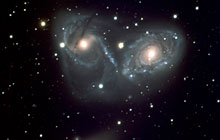VIMOS
VIsible Multi-Object Spectrograph
 “It is like having a time machine in the middle of desert, showing us how the Universe looked when it was just a third of its current age,” says Steffen Mieske, the instrument scientist behind the VIsible Multi-Object Spectrograph or VIMOS.
“It is like having a time machine in the middle of desert, showing us how the Universe looked when it was just a third of its current age,” says Steffen Mieske, the instrument scientist behind the VIsible Multi-Object Spectrograph or VIMOS.
VIMOS, guided by astronomers at Paranal Observatory, investigates hundreds of faint celestial objects at the same time. Most of these are far outside our own galactic neighbourhood.
 Observing these objects, at distances of up to several billion light-years, is like looking back in time, to 1.5 billion years after the Universe was born. This time machine lets the astronomers study the evolution of the Universe from that remote past up to today, “While other instruments specialise in very detailed investigations of individual objects, VIMOS allows large samples of objects to be analysed in one shot,” says Steffen Mieske.
Observing these objects, at distances of up to several billion light-years, is like looking back in time, to 1.5 billion years after the Universe was born. This time machine lets the astronomers study the evolution of the Universe from that remote past up to today, “While other instruments specialise in very detailed investigations of individual objects, VIMOS allows large samples of objects to be analysed in one shot,” says Steffen Mieske.
How? VIMOS takes an image of a region in the sky, containing hundreds of galaxies. The astronomer can identify which of those galaxies they are interested in, and mark about one hundred of them. A high-precision laser-cutter will use that information to drill little slits in a metal plate, at the exact position of the galaxies. This mask is then inserted in VIMOS, so that only the light of the interesting objects enters the instrument. Then, the light of those objects is split into its colour components by a prism-like device, yielding a spectrum. “If there were no mask blocking out the light from the less interesting objects, thousands of spectra would overlap and the data could not be analysed,” says Mieske.
The spectra are recorded on the four charge-coupled device (CCD) cameras mounted at the end of the instrument. “Instead of recording images of point sources, we record one long stripe (spectrum) for each object that reveals their composition and motion in space,” says Steffen Mieske.
Thanks to its capabilities to observe a hundred or so galaxies at the same time, VIMOS could collect the spectra of tens of thousands of galaxies over the history of the Universe, showing how they formed, grew and evolved.
Nevertheless, while VIMOS excels at taking spectra of hundreds of distant galaxies, it can also observe nearby galaxies. Given that these galaxies appear much bigger on the sky, taking a spectrum along a narrow slit is not enough, as most of the light the galaxy would fall outside the slit. To solve this, VIMOS has an integral field unit mode (IFU), which allows spectra to be taken in two dimensions. For each pixel on the galaxy, the IFU mode gives us a full spectrum. “It’s like taking thousands of images with different filters all at once. Thanks to this we can study in great detail the dynamics and composition of extended sources like galaxies and nebulae,” says Juan Carlos Muñoz, a former VIMOS instrument fellow.
VIMOS was used for the last time on 24 March 2018 and is now decommissioned.
Science highlights with VIMOS
- ESO Telescopes Observe First Light from Gravitational Wave Source (eso1733)
- Clues to the Mysterious Origin of Cosmic Rays (eso1308)
- The Feeding Habits of Teenage Galaxies (eso1212)
- The Most Distant Mature Galaxy Cluster (eso1108)
- Shedding Light on the Cosmic Skeleton (eso0941)
- A Pool of Distant Galaxies – the deepest ultraviolet image of the Universe yet (eso0839)
- How Do Galaxies Grow? (eso0824)
- New Light on Dark Energy (eso0804)
- VLT Survey Provides New Insight into Formation of Galaxies (eso0645)
- Large Population of Galaxies Found in the Young Universe with ESO's VLT (eso0530)
One of the quadrants from this raw image, coming straight from the instrument, was used, together with many others, to produce the image further up this page. The images taken with astronomical instruments are always in greyscale: the information on the colours is obtained by taking exposures through different glass filters. The camera contains four independent detectors, with gaps between them.
The four detectors of VIMOS collect the many spectra produced by its integral field spectrograph. In a traditional image, the intensity of each pixel is recorded. Here, the full spectrum of each pixel of the image is recorded as a vertical line, measuring the intensity of the light for all wavelengths. Specially written data analysis software is used to extract all these spectra and re-order the information according to the original pixel, into "images" that can be analysed by the astronomer.
VIMOSThe authoritative technical specifications as offered for astronomical observations are available from the Science Operation page.
|


